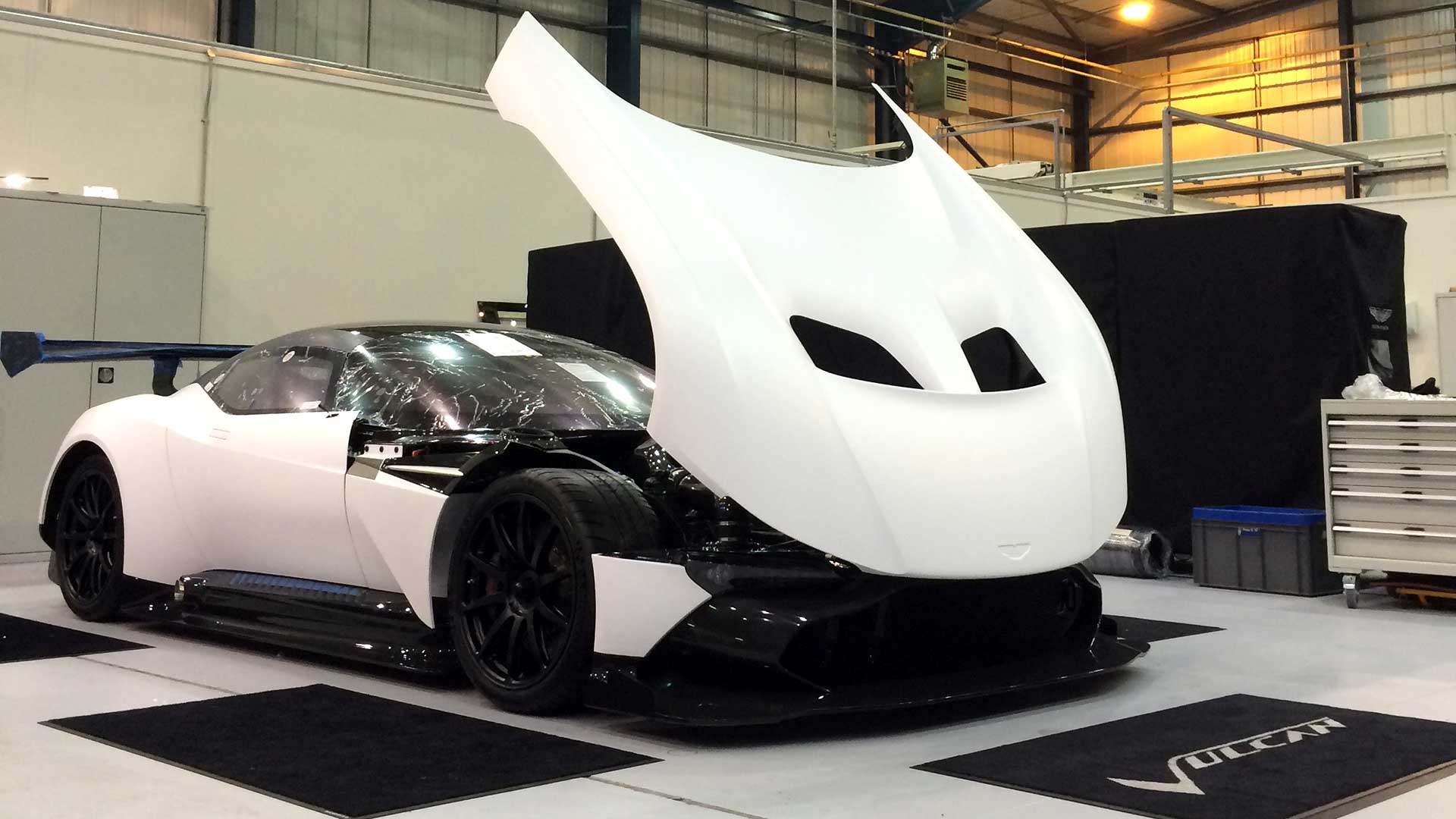

No one greets me when I walk into the carpeted lobby of the innocuous industrial park unit. The building is wedged beside a small airfield outside the tiny village of Wellesbourne, England, adjacent to Shakespeare’s Stratford-upon-Avon. My driver is clearly concerned that I’m in the wrong place. I sense this because a few minutes after dropping me at the door of the seemingly empty office, he comes shuffling inside and says, “I believe you’re in the wrong place.”
There’s a large painting of an Aston Martin GT4 racecar hanging on the wall. There are multiple copies of Aston Martin’s AM magazine, a smirking Daniel Craig gracing the cover, on the various coffee tables. And in the corner stands a giant banner featuring at least a dozen detailed beauty shots of the Vulcan, Aston’s limited-edition, $2.4-million, 820-horse, V12-powered carbon-fiber track car. “I’m pretty sure I’m where I’m supposed to be,” I reassure him.
This is proven out some minutes later when I’m finally joined, and ushered into a bland conference room, by some brand reps. These include Fraser Dunn, who runs this site, which is formally known as Q Advanced Operations. Dunn’s 40-member top-secret skunkworks division has only been sited in this appropriately incognito location for the past 18 months, but has been a part of the company for about a dozen years.

This is where it was discovered that the little Vantage coupe could indeed accept the insertion of a V12 engine; where advanced prototypes like the DBX crossover have been shepherded into existence; and where the vehicle’s of Aston’s most enduring and distinguished brand ambassador are engineered. “All of the Bond cars are built here,” Dunn says, almost as an afterthought.
It is also where the aforementioned Vulcan is being hand-assembled for the lucky 24 people well-connected, and well-funded, enough to acquire one. One-sixth of the world’s allotment of Vulcans is currently gathered in the large, brightly lit, white-on-white barn-ceilinged workroom. A finished blue metallic car sits perpendicular to a gray and red one. Two more nearly complete Vulcans sit parallel to each other behind Vulcan-liveried work mats. Each is covered in a matte white wrap, awaiting color selection by their owners.
A wooden pallet stacked with shrink-wrapped crates stands nearby. Some of these boxes are labeled “Tires and Wheels—Yas Marina,” referring to the United Arab Emirates circuit where the Abu Dhabi Formula 1 Grand Prix are held. It is also where the first Vulcan customer track day will soon occur. Eight Vulcans will be present for this gathering, along with the vehicles’ gentlemen-racer owners. Also present will be a team of professional instructors, there to provide the owners with sequential initiation into the Aston Martin racing family.

“We put them in a Vantage V12S, then a One-77, then a Vantage GT4 track car. And then we put them into their Vulcan,” Dunn says. Even after they’re allowed access to their own cars, there are three additional levels of training. The car has a trio of power settings, accessible via a knob on the dash, that allow one to control the engine’s output, and the owners must experience these in ascending order. “550 horsepower, 675 horsepower, and 820 horsepower,” Dunn says, clicking the switch.
Other switches on the elegant steering wheel—a $20,000 unit produced by Formula 1 engineering company Beru—control the level of intervention of ABS and traction control. Like every single bit of the Vulcan, these knobs can be customized. Dunn shows us a military-style padded attaché case, like the one in which an assassin would store his sniper’s rifle. Inside are carefully packed trim bits—toggles, rotary switches, side strakes, instrument bezels, winged Aston Martin badges—all made from machined carbon fiber so exquisitely burled that it resembles a fine wood veneer. This is a $28,000 option.

All of this training, expense and attention to detail is most intriguing when placed within the context of the Vulcan project. Unlike Aston’s GT3 or GT4 programs, there is no larger global racing series, with their fussy rules and requirements, to support or constrain the vehicles. Rather, the Vulcan exists solely in its own exclusive world. Its prodigious downforce-creating rear wing is not to code, nor is its length or width or weight, though all have been engineered with optimal performance in mind.
The car is an ultimate automotive vanity project, and the seven-figure passkey into an ultra-exclusive club. And creating these elite and expensive opportunities for the marque’s chosen few is a key strand of Aston Martin’s current product plan. “Andy [Palmer, Aston’s CEO] has made it clear that we plan to release at least one low-volume Vulcan-style project every year,” says Matthew Clarke, the brand’s North American communications manager.

Each of these will be built here in Wellesbourne. In fact, there is a cordoned-off section behind one of the finished Vulcans that my hosts won’t allow me to see, where I expect just that is happening.
Dunn pushes the steering wheel’s anodized red metal Start button. After quite a bit of controlled whirring, the 7-liter V12 animates and seizes control of the cavernous room. When Dunn floors the throttle, flames shoot from the wide, carbon fiber-framed, side mounted exhaust pipes. The rich smell of an F1 paddock fills the room.